
Louwrens Hanedoes (14 July 1822, Woudrichem - 9 February 1905, Woudrichem) was a Dutch landscape painter; in the Romantic style at first, later turning to Realism.

Louwrens Hanedoes (14 July 1822, Woudrichem - 9 February 1905, Woudrichem) was a Dutch landscape painter; in the Romantic style at first, later turning to Realism.
From 1839 to 1840, he studied at the Royal Academy of Art with Cornelis Kruseman and Barend Cornelis Koekkoek, [1] who was especially influential on his style. From the beginning, he preferred landscapes, travelling to mountainous areas such as the Pyrenees, Switzerland and the Eifel. His favorite spots in the Netherlands were Arnhem and Oosterbeek. [2]
Shortly after 1850, he became one of the first Dutch painters to visit Barbizon, [3] where he was strongly influenced by the Barbizon school of artists and changed to a more realistic style of painting. Many critics consider his work to be a precursor to the Hague School.
In 1863, he was named a Ridder in the Order of Leopold. [1] After that point, his productivity declined and he eventually retired to his family estate in Woudrichem, where he died in 1905. Streets were named after him in Benoordenhout and Eindhoven.
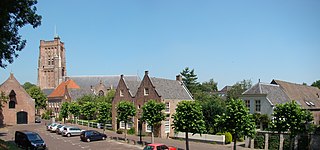
Woudrichem is a city and former municipality in the province of North Brabant in the Netherlands.

George Inness was a prominent American landscape painter.

The Barbizon school of painters were part of an art movement towards Realism in art, which arose in the context of the dominant Romantic Movement of the time. The Barbizon school was active roughly from 1830 through 1870. It takes its name from the village of Barbizon, France, on the edge of the Forest of Fontainebleau, where many of the artists gathered. Most of their works were landscape painting, but several of them also painted landscapes with farmworkers, and genre scenes of village life. Some of the most prominent features of this school are its tonal qualities, color, loose brushwork, and softness of form.
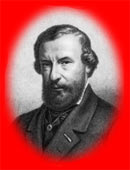
Constant Troyon was a French painter of the Barbizon school. In the early part of his career he painted mostly landscapes. It was only comparatively late in life that Troyon found his métier as a painter of animals, and achieved international recognition.

Karel van Mander (I) or Carel van Mander I was a Flemish painter, poet, art historian and art theoretician, who established himself in the Dutch Republic in the latter part of his life. He is mainly remembered as a biographer of Early Netherlandish painters and Northern Renaissance artists in his Schilder-boeck. As an artist and art theoretician he played a significant role in the spread and development of Northern Mannerism in the Dutch Republic.

Landscape painting, also known as landscape art, is the depiction of natural scenery such as mountains, valleys, trees, rivers, and forests, especially where the main subject is a wide view—with its elements arranged into a coherent composition. In other works, landscape backgrounds for figures can still form an important part of the work. Sky is almost always included in the view, and weather is often an element of the composition. Detailed landscapes as a distinct subject are not found in all artistic traditions, and develop when there is already a sophisticated tradition of representing other subjects.

The Hague School is a group of artists who lived and worked in The Hague between 1860 and 1890. Their work was heavily influenced by the realist painters of the French Barbizon school. The painters of the Hague school generally made use of relatively somber colors, which is why the Hague School is sometimes called the Gray School.

Henry Ward Ranger was an American artist. Born in western New York State, he was a prominent landscape and marine painter, an important Tonalist, and the leader of the Old Lyme Art Colony. Ranger became a National Academician (1906), and a member of the American Water Color Society. Among his paintings are, Top of the Hill, Corcoran Gallery of Art, Washington, D.C.; and East River Idyll, Carnegie Institute, Pittsburgh, Pennsylvania.
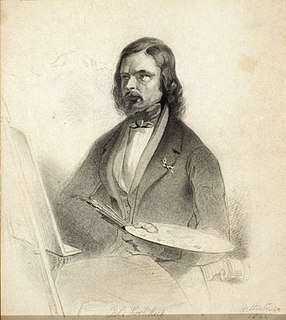
Barend Cornelis Koekkoek was a Dutch landscape artist and lithographer.

Jan Hendrik Weissenbruch, also known as Hendrik Johannes Weissenbruch was a Dutch painter of the Hague School. He is noted especially for his watercolours.

Cornelis van Poelenburgh or Cornelis van Poelenburch, was a Dutch landscape painter and draughtsman. He was the leading representative of the first generation of Dutch landscape painters who were active in Rome in the early 17th century. He was known for small-scale paintings depicting Italianate landscapes with small figures enacting biblical or mythological scenes or in contemporary attire.

Tobias Verhaecht (1561–1631) was a Flemish painter primarily of landscapes. His style was indebted to the mannerist world landscape developed by artists like Joachim Patinir and Pieter Bruegel the Elder. He was the first teacher of Pieter Paul Rubens.
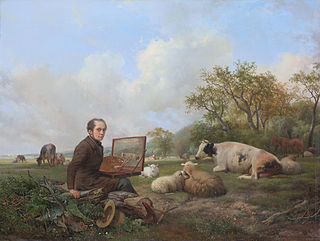
Hendrik (Hendrikus) van de Sande Bakhuyzen was a Dutch landscape painter and art teacher. He was a prominent contributor to the Romantic period in Dutch art and his students and children founded the art movement known as the Hague School. Like his contemporaries Edward Williams, Jacob Maris, and Jozef Israels, he was part of a family of prominent painters, including son Julius van de Sande Bakhuyzen, daughter Gerardina Jacoba van de Sande Bakhuyzen, and nephew Alexander Hieronymus Bakhuyzen.

Pulchri Studio is a Dutch art society, art institution and art studio based in The Hague ('s-Gravenhage), Netherlands.
California Tonalism was art movement that existed in California from circa 1890 to 1920. Tonalist are usually intimate works, painted with a limited palette. Tonalist paintings are softly expressive, suggestive rather than detailed, often depicting the landscape at twilight or evening, when there is an absence of contrast. Tonalist paintings could also be figurative, but in them, the figure was usually out of doors or in an interior in a low-key setting with little detail.
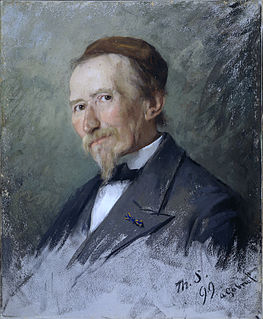
Paul Joseph Constantin Gabriël or Paul Gabriël was a painter, draftsman, watercolorist, and etcher who belonged to the Hague School.
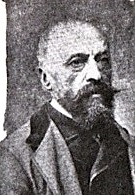
Carlo Pittara was an Italian painter who specialized in animals, pastoral landscapes, rivers and peasants at work. He was also the leader of what came to be known as the Scuola di Rivara.

Louis Victor Antonio Artan de Saint-Martin was a Dutch-Belgian painter and etcher who specialized in seascapes.

Ludolph Georg Julius Berkemeier was a Dutch landscape and cityscape painter; associated with the Düsseldorfer Malerschule and the Hague School.

Altena is a municipality in the Netherlands, on a river island in the very north of the province of North Brabant, bordering the provinces of Gelderland and South Holland. Nearby cities are Dordrecht in the west, Gorinchem in the north, and Waalwijk in the south.

![]() Media related to Louwrens Hanedoes at Wikimedia Commons
Media related to Louwrens Hanedoes at Wikimedia Commons
| | This article about a Dutch painter is a stub. You can help Wikipedia by expanding it. |